A misnomer, the freshwater “sharks”, aren’t really sharks with predatory behavior or heightened sensory abilities. Thanks to the similar appearance of a few bony fish species, they’re commonly referred to as freshwater sharks for aquariums. In addition, most of them thrive when kept in groups, contrary to the natural secluded behavior of real sharks.
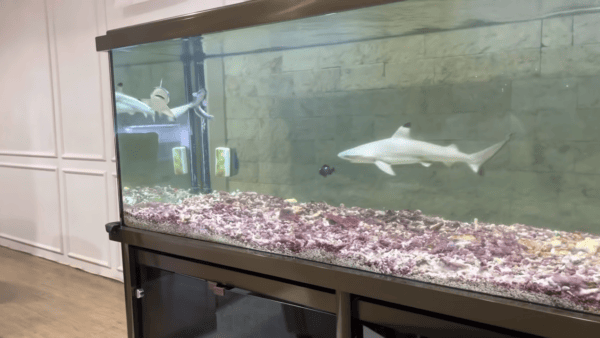
In this article, we’ll go through a few freshwater shark species and discuss their origin, appearance, characteristics, and tank requirements.
Table of Contents
10 Freshwater Sharks for Aquarium
1. Bala Shark
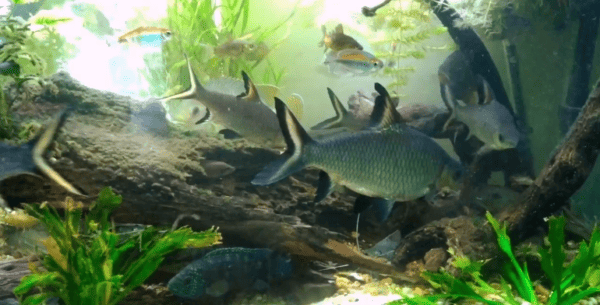
| Scientific Name: | Balantiocheilos melanopterus |
| Family: | Cyprinidae |
| Care Level: | Moderate |
| Temperament: | Peaceful, Skittish |
| Color: | Silver with black and yellow fins |
| Lifespan: | 8-10 years |
| Size: | Up to 14 inches |
| Diet: | Omnivorous. Pellets, flakes, live/frozen food |
| Minimum Tank Size: | 75 gallons. Larger tanks as they grow. |
| Temperature: | 72 to 82 F |
| Water Conditions: | pH: 6.5 – 7.5 Moderately hard water |
| Tank Mate Compatibility | Similar size peaceful fish |
Bala sharks are native to Southeast Asia and are found in the Malay Peninsula, Sumatra, and Borneo. While they also are seldom found in the Mekong River Basin, these populations are believed to be captive-bred.
They have long slender bodies with translucent fins and a silver-scaly appearance throughout their body. Black stripes are found along the edges of their fins, including the tail. As they mature, the black stripes fade and leave them with a gracious silvery-white body.
Bala sharks are generally peaceful schooling fish and should be kept in a group of 3 to 5. They also do well in community aquariums. Moreover, being pretty hardy fish, they’re easy to care for.
They typically show a shy demeanor and spend most of their time swimming in the middle or upper levels of the tank. Although they may not demonstrate hostility to other fish, fin-nipping behaviors are prevalent in Bala Sharks.
As for tank requirements, the technical details have already been mentioned, a few special tank requirements may include:
- A long and wide tank for active horizontal swimming.
- Regular water changes and powerful filtration is required to sustain Bala Sharks, as they’re pretty sensitive toward ammonia and nitrite levels.
- Provide hiding spots with rocks and driftwood without hindering their swimming behavior.
- Simulating the rivers and streams, Bala Sharks prefer a moderate water flow.
- Provide a well-fitted lid to prevent them from jumping.
2. Redtail Shark
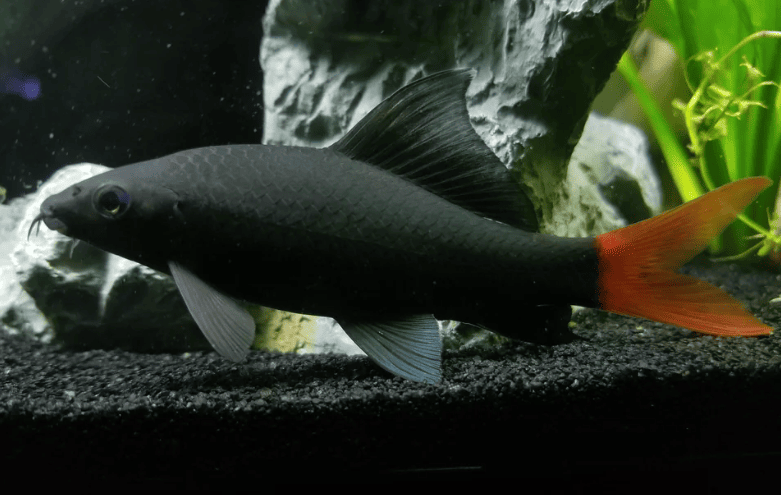
| Scientific Name: | Epalzeorhynchos bicolor |
| Family: | Cyprinidae |
| Care Level: | Easy |
| Temperament: | Semi-aggressive |
| Color: | Dark black body with red tail fin |
| Lifespan: | 5 – 8 years |
| Size: | Up to 6 inches |
| Diet: | Omnivorous. Pellets, flakes, live/frozen food |
| Minimum Tank Size: | 50 gallons |
| Temperature: | 72 to 79 F |
| Water Conditions: | pH 6.5 – 7.5 Moderate water hardness |
| Tank Mate Compatibility | Semi-aggressive fish. Avoid fin-nippers. |
Originating in the Chao Phraya River basin in Thailand and rarely found in the Mekong River basin, the Redtail Shark has found its spot among the freshwater sharks for aquariums. Owing to the challenges to breed them in captivity and overfishing for aquariums, Redtails are endangered in their natural habitat.
Graciously vibrant, the Redtail Shark has a slender shape with a red tail and a black or silver body. While they grow up to 12 inches in the wild, their length is cut short in captivity. They also have a pair of sensory barbels near their mouth.
Redtail Sharks exhibit semi-aggressive behavior towards other fish, especially those of their own species. They can be a bit territorial and nip at the fins of other fish if enough space isn’t provided. However, they can be kept in community tanks if enough hiding places are offered.
Overall, they’re mostly shy fish and spend most of their time swimming in the middle and exploring the bottom of the tank. Although they can be kept in schools, they don’t particularly form a tight bond.
As for tank requirements, a rectangular tank with enough swimming space and smooth decorations, such as plants and toys, should be enough for your Redtails to thrive.
3. Rainbow Shark
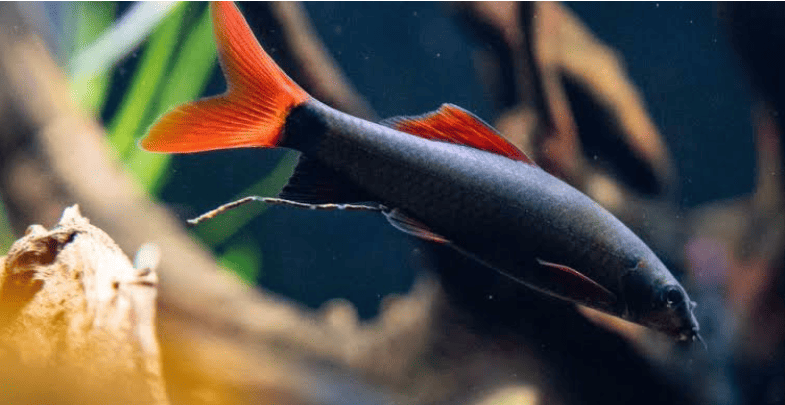
| Scientific Name: | Epalzeorhynchos frenatum |
| Family: | Cyprinidae |
| Care Level: | Easy |
| Temperament: | Semi-aggressive |
| Color: | Bluish gray body with red/orange fins and tail |
| Lifespan: | 5 – 8 years |
| Size: | Up to 6 inches |
| Diet: | Omnivorous. Pellets, flakes, live/frozen food |
| Minimum Tank Size: | 40 gallons |
| Temperature: | 72 to 79 F |
| Water Conditions: | pH 6.5 – 7.5 Moderate water hardness |
| Tank Mate Compatibility | Other semi-aggressive fish. |
Native to Southeast Asia and found in rivers of Thailand, Laos, and Malaysia, the Rainbow Sharks are relatively hardy fish and are easy to care for. Additionally, their natural habitat consists of sandy river beds.
These freshwater aquarium sharks are similar in appearance to Redtail Sharks, but are visually more colorful and have a bluish tint on their body, a hint of yellow/red/orange on their tails, and occasional black stripes on the edges of the fins. They can be identified by their pointed snout and forked tail.
While your Rainbows may nip the fins of other peaceful members of smaller community tanks, they usually are pretty shy and like to keep hidden behind decorations and plants. Therefore, don’t forget to give them enough hiding places.
As their natural habitat consists of fast-flowing rivers and streams, Rainbow Sharks thrive on a strong water current. Moderately hard water with enough horizontal swimming space should be provided to them.
Their black and yellow stripes are thought to be a part of their camouflage to blend in the sand substrates of their natural habitat.
4. Black Shark
| Scientific Name: | Labeo chrysophekadion |
| Family: | Cyprinidae |
| Care Level: | Moderate |
| Temperament: | Semi-aggressive |
| Color: | Black body with silvery-white band stretching from the head to tail. |
| Lifespan: | 5 to 10 years |
| Size: | 12 to 14 inches |
| Diet: | Omnivorous. Pellets, flakes, live/frozen food |
| Minimum Tank Size: | 70 to 100 gallons |
| Temperature: | 72 to 82F |
| Water Conditions: | pH: 6.5 – 7.5 Moderate water hardness |
| Tank Mate Compatibility | Similar semi-aggressive fish species |
Black Sharks are native to rivers of Thailand, Malaysia, and Indonesia, and are frequently found in shallower stagnant waters with vegetation and rocks. They usually prefer muddy, sandy, or rocky substrates, similar to their natural habitat.
They undertake migratory movements during rainy seasons in search of food.
These freshwater aquarium sharks, as their name suggests, predominantly have a black body with silver bands extending horizontally along their sides.
Juvenile Black Sharks often exhibit a more silvery appearance with a more slender body. Adult Blacks are more elongated and wider in the middle.
Black Sharks are usually quite peaceful but can become moderately aggressive during adulthood. They love to play around the tanks and don’t show any predatory intent towards tank mates, despite their large size.
In community tanks, however, they may nip the fins of other slow-moving species.
Owing to their large size, a tank size of 70 – 100 gallons is recommended to keep a single Black Shark. Moreover, if you intend to keep multiple, provide enough hiding spots and horizontal swimming space for them to hide and explore.
Furthermore, they’re known to be jumpers when startled. Provide a well-fitting tank lid to prevent unfortunate events.
5. Columbian Shark
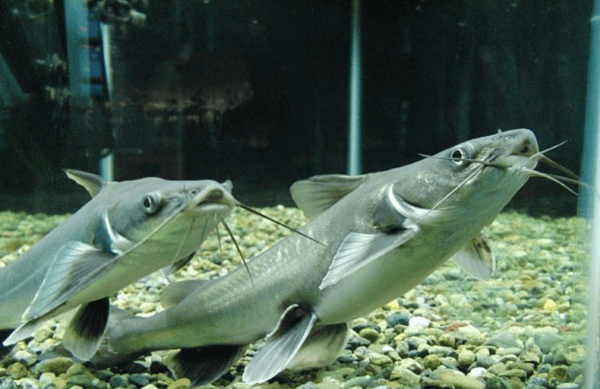
| Scientific Name: | Ariopsis seemanni |
| Family: | Ariidae |
| Care Level: | Easy |
| Temperament: | Peaceful |
| Color: | Grayish brown with a white belly |
| Lifespan: | 10 – 15 years |
| Size: | Up to 15 inches |
| Diet: | Carnivorous—Live or frozen meaty food |
| Minimum Tank Size: | 75 gallons |
| Temperature: | 75 to 82 F |
| Water Conditions: | pH 7.0 – 8.0 Slightly hard water |
| Tank Mate Compatibility | Peaceful community species |
Found in Pacific-draining rivers and estuaries in Central and South America, the Columbian Shark is a species of large catfish. They’re most common in the Gulf of California and the Pacific Coast of Columbia. These freshwater aquarium sharks prefer sandy substrates and bury themselves to hide from predators.
Columbian Sharks have a long, slender body with a flattened head and a disproportionately large mouth. They exhibit a gray body with black fins and a white belly. They also are identified with their three pairs of barbers, used to sense the environment.
Although this species of “shark” is pretty shy and prefers to be left in solitary, you can keep up to 5 Columbian Sharks in a large tank. Being active swimmers and scavengers, they prefer larger horizontal swimming spaces and plenty of hiding places.
If you choose to keep them in community tanks, make sure to mate them up with other peaceful species with a preference towards driftwood and rocks. While they also travel to the freshwater rivers, slightly brackish water is recommended for Columbian sharks.
The Columbian Shark is a mouthbrooder, meaning their males hold the eggs in their mouth and incubate them for about 4 weeks. They also are migratory fish and travel to freshwater rivers to raise their young.
6. Roseline Shark
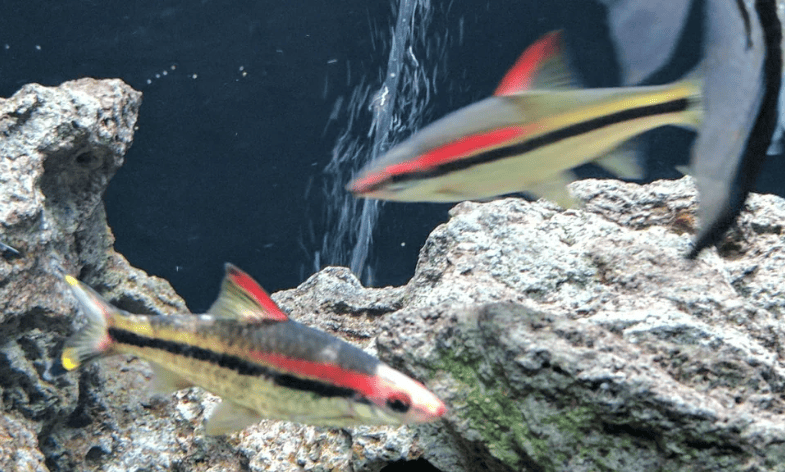
| Scientific Name: | Puntius denisonii |
| Family: | Cyprinidae |
| Care Level: | Moderate |
| Temperament: | Semi-aggressive |
| Color: | Rosy-pink body with a hint of silver along the sides. |
| Lifespan: | 5 – 7 years |
| Size: | Up to 6 inches |
| Diet: | Omnivorous. Pellets, flakes, live/frozen food |
| Minimum Tank Size: | 55 gallons |
| Temperature: | 72 to 79F |
| Water Conditions: | pH: 6.5 – 7.5 Low to moderate hardness |
| Tank Mate Compatibility | Similar peaceful or semi-aggressive fish |
Now endangered and rarely found in nature, the Roseline Shark or Danison Barb is a native species to the Western Ghats of India. Generally found in the states of Kerala and Karnataka, this species inhibits clear and fast-flowing rivers with rocky substrates.
Thanks to their sticking appearance, the Roseline Sharks have found their way to the aquarium industry, where they’re breeding and thriving. It has a torpedo-like slender body with bright rosy-pink coloration that extends to the tail.
A silver or gray line, with an orange edge, runs horizontally across its body to introduce an orange or black tail. Other fins are typically transparent.
Roseline Sharks prefer to stay in groups rather than alone. They exhibit schooling behavior in well-maintained and clean aquariums with lots of hiding space. These barbs love to explore the decorations and stay playful with their tank mates. However, they may get a bit territorial during breeding time.
Keep them with other peaceful and non-aggressive species in community tanks. Give them enough space to hide and swim around. Avoid slow-moving and large-fin tank mates, as the Roseline Sharks may nip on their fins.
Denison Barbs prefer a fast-moving water current. While not essential, providing them with a moderate flow can help with reducing stress and enhancing colors. They also are migratory fish that move up streams in response to monsoons. Therefore, regular water changes and cool water can help them have a healthier life.
7. Chinese High-Fin Banded Shark
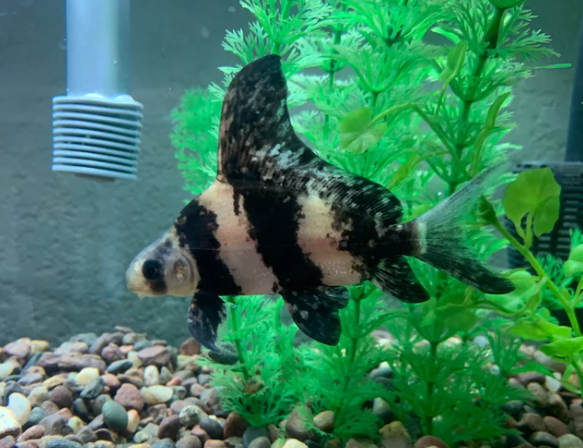
| Scientific Name: | Myxocyprinus asiaticus |
| Family: | Catostomidae |
| Care Level: | Moderate |
| Temperament: | Peaceful |
| Color: | Dark gray or brown with a lighter underbelly |
| Lifespan: | 20 to 30 years |
| Size: | Up to 30 inches |
| Diet: | Herbivorous |
| Minimum Tank Size: | 125 gallons |
| Temperature: | 65 to 75F |
| Water Conditions: | pH: 6.5 – 7.5 Moderate water hardness |
| Tank Mate Compatibility | Peaceful non-aggressive mates |
Originating in the Yangtze River basin in China, The Chinese High-Fin is one of the largest freshwater “sharks” for aquariums in existence. These species of barbs migrate to headwater to spawn but spend most of their time in river sections. Their Min River population, however, has crumbled with increasing pollution and overfishing.
The most distinct features of the Chinese High-Fin Banded Shark are the high dorsal fin and black bands. They exhibit a rosy-pink or silver body coloration with the bands running along the lateral line along the gills to their tail. The high dorsal fin stands tall and adds to its overall glorious appearance.
As individuals, the High-Fins are pretty peaceful and don’t show aggressive behavior towards other species or their own. They typically have a shy disposition and like to hide in dim, hidden areas. But, as they grow larger, they may compete with other tank mates for space and privacy.
As a community species, avoid putting them in a tank with aggressive fin-nipping fish. They may target the shark’s long-flowing fins. Pair them up with similar-sized peaceful species.
As for tank requirements, larger is better. Give them enough space to swim around and hide. They feel more secure in a natural-looking setup. So, try to include driftwood and live plants in the aquarium. Moreover, keep a moderate water flow in the tank.
Chinese High-Fin Banded Sharks demonstrate a unique behavior called “corkscrewing” when feeding, they twist and turn—adding to their overall appeal. They also can live decades in captivity if proper care is given.
8. Silver Apollo Shark
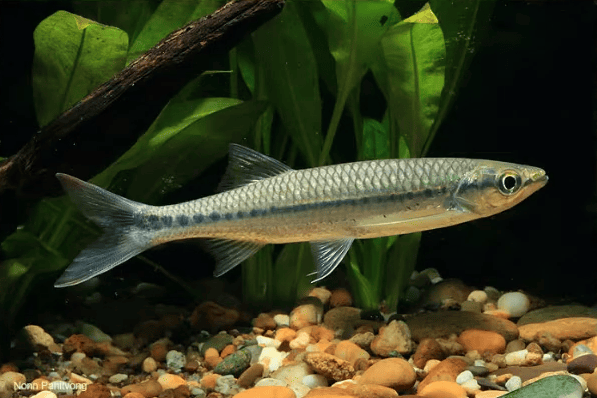
| Scientific Name: | Luciosoma setigerum |
| Family: | Cyprinidae |
| Care Level: | Easy |
| Temperament: | Peaceful |
| Color: | Light black and brown, with dark lines running vertically along their body |
| Lifespan: | 12-15 years |
| Size: | Up to 10 inches |
| Diet: | Omnivorous. Pellets, flakes, live/frozen food |
| Minimum Tank Size: | 125 gallons for 6 fish |
| Temperature: | 68 to 77F |
| Water Conditions: | pH: 6.5 to 7.5 Soft to medium water hardness |
| Tank Mate Compatibility | Similarly sized peaceful species |
Found in slow-moving rivers in Thailand, Malaysia, Indonesia, Cambodia, and parts of Vietnam, the Silver Apollo Shark inhibits water bodies with dense vegetation and submerged rocks. Being a hatchetfish species, they often jump out of the water to catch small insects and other prey in their natural habitat.
Silver Apollo Sharks have a torpedo-like shape that gives them the “shark” name. Other than that, they have a silver appearance and are built to swiftly swim away. A horizontal black stripe runs from the eyes to the tail. Their eyes are relatively larger than their body proportions.
This freshwater shark for aquariums is generally a peaceful and active species. They’re renowned for their strong swimming and maneuvering abilities. Being relatively shy, they prefer to hide in the tank behind vegetation and decorations.
They also display schooling behavior when kept in a group and feel safe around their own. However, ensure that they’re given enough tank space to swim around and hide. Otherwise, they may get agitated and behave aggressively.
As for tank setup, a well-fitting lid and lots of live plants are critical. Do consider plants with bigger and softer leaves for a lush backdrop and smaller plants in the front. The silver appearance of these sharks adds a touch of grace to planted tanks.
9. Iridescent Shark
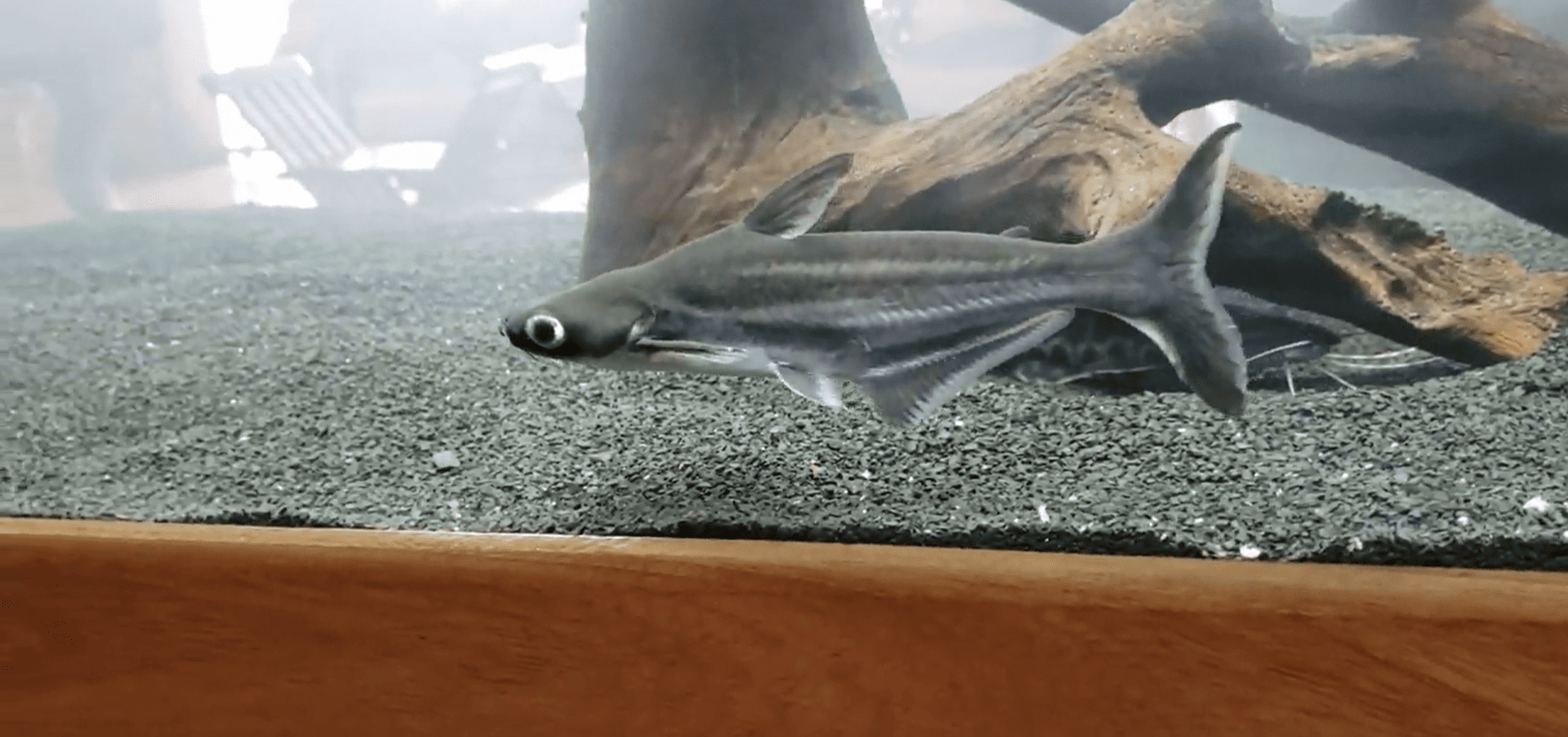
| Scientific Name: | Pangasianodon hypophthalmus |
| Family: | Pangasiidae |
| Care Level: | Moderate to difficult |
| Temperament: | Peaceful. Skittish in small tanks |
| Color: | Silvery-white iridescent sheen, that becomes darker with age |
| Lifespan: | 10 – 15 years |
| Size: | 3 to 4 feet |
| Diet: | Omnivorous. Pellets, flakes, live/frozen food |
| Minimum Tank Size: | Larger freshwater pond |
| Temperature: | 72 to 80F |
| Water Conditions: | pH: 6.5 to 7.5 Moderate water hardness |
| Tank Mate Compatibility | Larger non-aggressive fish |
Originating from the Mekong River in countries such as Thailand, Cambodia, Laos, and Vietnam, the Iridescent Shark is the biggest freshwater shark for aquariums. Living up to 15 years, this giant species is also known as Sutchi Catfish and Striped Catfish.
Although adults display a faint silver sheen, juveniles have the most pronounced blue and green iridescence on their bodies. As they age, they develop a darker color with a white belly. They also have a pair of barbels near their mount—acting as sensory organs.
As individuals, these “sharks” stay quite active and curious in their early ages. However, as they grow older, they may become more sedentary and spend their time resting at the bottom.
In a community setup, only if you have a large pond, can they live happily in a group of 3. If not, they may outgrow the tank and become cumbersome for the tank mates.
A well-fitting lid is necessary when keeping Iridescent Sharks, as they’re known to be skilled jumpers. But, the criticality of the lid minimizes with their size and age. They also are pretty active swimmers and prefer a horizontal tank to a deep one.
Iridescent Sharks are primarily filter-feeders, meaning they use their specialized gill rakers to sieve plankton and small food particles from water. They also go through migratory movements in nature during rainy seasons.
10. Harlequin Shark
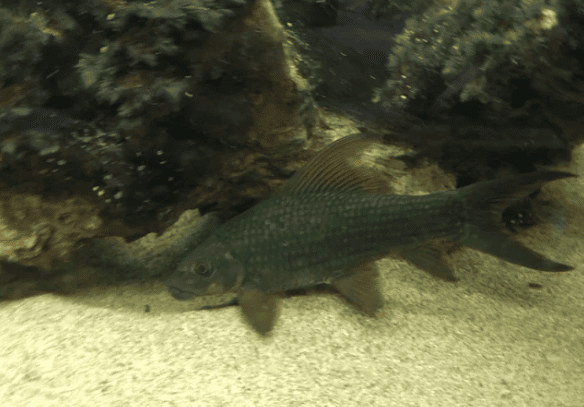
| Scientific Name: | Labeo cyclorhynchus |
| Family: | Cyprinidae |
| Care Level: | Moderate |
| Temperament: | Territorial, semi-aggressive |
| Color: | Lighter orange or red with dark mottling all over its body and fins |
| Lifespan: | 5 to 8 years |
| Size: | 5 to 7 inches |
| Diet: | Omnivorous. Pellets, flakes, live/frozen food |
| Minimum Tank Size: | 40 gallons |
| Temperature: | 73 to 84F |
| Water Conditions: | pH: 6.5 – 7.5 Moderate water hardness |
| Tank Mate Compatibility | Other peaceful or semi-aggressive fish |
Harlequin sharks are native to the Congo River basin in central Africa. They inhibit the large river system that flows through countries such as the Democratic Republic of the Congo, the Republic of the Congo, and Angola. These freshwater sharks for aquariums thrive in slow-moving rivers and swamps with muddy and sandy substrates.
They travel hundreds of miles upstream in the spawning season, which leaves them vulnerable to fishing and other predators.
In Juvenile Harlequins, a creamy yellow or even orange coloration can be observed with black mottling on their body and fins. They get their vernacular name of shark due to having an elongated body and stiff fins.
As they start to mature, the markings fade out and their whole body typically turns to dark brown or light black. Sexual dimorphism is also observed in this species with females having much thicker bodies than males.
The Harlequin Sharks are somewhat territorial and exhibit semi-aggressive behavior towards smaller fish. You can keep a few, ideally 5, Harlequins together to fulfill their social behavior.
However, with proper care, hiding places, and adequate swimming space, they can become great members of your freshwater aquarium. Just don’t forget to add a well-fitting lid to prevent them from jumping out.
FAQs
No, the freshwater sharks for aquariums aren’t real sharks. They are mostly species of carp, barbs, and hatchet fish. They get their name from a few vague resemblances with real sharks, such as stiff fins, torpedo-shaped bodies, and active swimming habits.
Roseline sharks are the smallest freshwater aquarium sharks, with them growing to only 6 inches. Although they get much bigger in the wild, their growth is slowed down in captivity.
Most freshwater aquarium sharks aren’t aggressive. However, they may occasionally display aggression towards their own during mating seasons or towards others due to lack of space. In community tanks, it’s recommended to provide these sharks with adequate swimming and hiding space to keep them healthy.
The largest freshwater aquarium shark is the Chinese High-Fin Banded Shark and Iridescent Shark. They both grow over 30” in the wild and can reach a similar length in captivity, given proper care and nutrition.
The Bottom Line
We’ve listed 10 freshwater aquarium sharks that you can keep in your aquarium, depending on your preference and tank size. If adequate space can be provided, most of these sharks are best to be kept in small groups. Hopefully, you’ll now be able to enjoy giving care to them and experience their unique activities.
No related posts.
